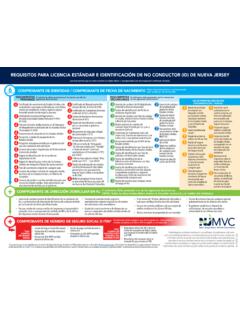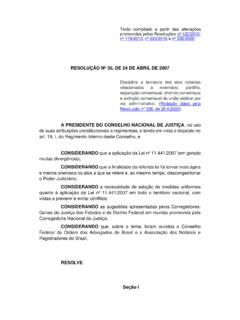Transcription of SF3.1: Marriage and divorce rates - OECD
1 OECD Family Database OECD - Social Policy Division - Directorate of Employment, Labour and Social Affairs Updated: 25-08-16 1 : Marriage and divorce rates Definitions and methodology This indicator presents information on marriages through three measures: The crude Marriage rate (CMR), defined as the number of marriages during the year per 1000 people. The mean age at first Marriage , defined as the mean age in years of marrying persons at the time of Marriage . This measure is disaggregated by sex with separate averages for men and women. The distribution of marrying persons by previous marital status, or the proportion of all marrying people with known previous marital status who were previously single never married , divorced , or widowed . divorce is captured by one measure: The crude divorce rate (CDR), defined as the number of divorces during the year per 1000 people.
2 Key findings Crude Marriage rates (CMRs) differ considerably across OECD countries (Chart ). In some such as Chile, Italy, Luxembourg, Portugal, Spain and Slovenia CMRs are very low at or fewer marriages per 1000 people. In others such as the United States and Turkey rates are twice that at around 7 per 1000 or above. However, in most OECD countries CMRs are somewhere between 4 and marriages per 1000, with the OECD average standing at rates of Marriage are declining in almost all OECD countries (Chart ). In 1970, most OECD countries had a CMR of around 7 to 9 marriages per 1000 people; by 1995, CMRs had fallen to the extent that most had a rate of around 5 to 7 marriages per 1000 people. And in many OECD countries, CMRs continued to fall after 1995. In Portugal, for example, CMRs more than halved between 1995 and 2014 from marriages per 1000 in the former to in the later while in four others (Chile, Korea, Luxembourg and Mexico) CMRs fell by at least 2 marriages per 1000.
3 Only Ireland, Latvia and Sweden saw CMRs increase between 1995 and 2014 (or nearest available). Other relevant indicators: Family size and composition ( ); Fertility rates ( ); Mean age of mother at first childbirth ( ) and Share of births outside Marriage ( ); and Cohabitation rates and prevalence of other forms of partnership ( ). OECD Family Database OECD - Social Policy Division - Directorate of Employment, Labour and Social Affairs Updated: 25-08-16 2 Chart Crude Marriage rate, 1970, 1995 and 2014 or latest available yeara Marriages per 1000 people a) Data for Iceland and the United Kingdom refer to 2011, for Belgium, France, Ireland, Israel, China and the Russian Federation to 2012, and for Austria, Chile, and Cyprus to 2013 b) Data for New Zealand include civil unions. c) The statistical data for Israel are supplied by and under the responsibility of the relevant Israeli authorities.
4 The use of such data by the OECD is without prejudice to the status of the Golan Heights, East Jerusalem and Israeli settlements in the West Bank under the terms of international law. d) Footnote by Turkey: The information in this document with reference to Cyprus relates to the southern part of the Island. There is no single authority representing both Turkish and Greek Cypriot people on the Island. Turkey recognizes the Turkish Republic of Northern Cyprus (TRNC). Until a lasting and equitable solution is found within the context of United Nations, Turkey shall preserve its position concerning the Cyprus issue ; e) Footnote by all the European Union Member States of the OECD and the European Commission: The Republic of Cyprus is recognized by all members of the United Nations with the exception of Turkey. The information in this document relates to the area under the effective control of the Government of the Republic of Cyprus.
5 Sources: for European countries, Eurostat Demographic Statistics; for Australia, Australian Bureau of Statistics; for Costa Rica, INEC; for Chile, INE; for Israel, CBS; for Japan, Statistics Japan; for Korea, Korean Statistical Information Service; for Mexico, INEGI; for New Zealand, Statistics New Zealand; for the United States, Centers for Disease Prevention and Control; for all countries, United Nations World Marriage Data 2008; for all countries, United Nations Demographic Yearbook Across the OECD, declining CMRs have been accompanied by increases in the average age of those getting married (Chart ). At the start of the 1990s the OECD-25 average mean age at first Marriage for women was (Panel A), while the OECD-25 average mean age for men was (Panel B). By 2014, the OECD-25 average mean age at first Marriage for both women and men had increased by about 5 years to and , respectively.
6 In no OECD country did the average age of either women or men at first Marriage fall between 1990 and 2014 (or nearest available). Despite common historical trends there remain notable differences between countries in the ages of individuals at Marriage (Chart ). The mean age of both women and men at first Marriage is very high in the Nordic countries, for example, especially Sweden where the mean age for women reaches as high as and for men In Israel and in Turkey, by contrast, the average age of women at first Marriage is below 25 and of men is less than 28. The difference between countries points to a variety of transition paths towards the formation of long-term partnerships: cohabitation has become an important form of long-term partnership in, for example, the Nordic countries, postponing and frequently replacing Marriage as the partnership standard ( ).
7 024681012 Marriages per 1000 people 201419701995 OECD Family Database OECD - Social Policy Division - Directorate of Employment, Labour and Social Affairs Updated: 25-08-16 3 Chart Meana age at first Marriage by sex, 1990, 2000 and 2014 or latest available yearb a) For Australia, Israel, New Zealand and the United States, median age at first Marriage b) Data for Belgium refer to 2010, for France, Iceland, Ireland and Malta to 2011, for Austria and the United Kingdom to 2012, and for Chile and Israel to 2013 c) For Mexico, data refer to all marriages and not only first marriages. d) Data for New Zealand include civil unions. From 2007 onwards, data include those who transferred their civil union to a Marriage . e) See note c) in chart Sources: for European countries, Eurostat Demographic Statistics; for Australia, Australian Bureau of Statistics; for Chile, INE; for Israel, CBS; for Japan, Statistics Japan; for Korea, Korean Statistical Information Service; for Mexico, INEGI; for New Zealand, Statistics New Zealand; for the UK, Office for National Statistics; for the United States, US Census Bureau Declining rates of Marriage have also been accompanied by increases in Crude divorce rates (CDRs) (Chart ).
8 CDRs vary across countries from as low as divorces per 1000 people in Chile to as high as in Denmark but in comparison to 1970, for example, current CDRs in most OECD countries are generally high. The OECD average CDR increased by over 50 percent between 1970 and 2012 from divorces per 1000 in 1970 to in 2012 with CDRs increasing in most OECD countries between the two time points. In recent years trends in divorce rates have become a little more mixed (Chart ). In some OECD countries CDRs have continued to increase between 1995 and 2014 (or nearest available), for instance, CDRs increased in 14 of those OECD countries with available data. In others, however, they have 05101520253035 Mean age Panel A. Female mean age at first Marriage 2014199020000510152025303540 Mean age Panel B. Male mean age at first Marriage OECD Family Database OECD - Social Policy Division - Directorate of Employment, Labour and Social Affairs Updated: 25-08-16 4 started to fall.
9 In Australia, Belgium, the Czech Republic, Norway, New Zealand and the United Kingdom, for example, CDRs fell by at least divorces per 1000 people between 1995 and 2014. Declines since 1995 are most pronounced though in the United States (where the CDR fell from divorces per 1000 in 1995 to in 2014) and Estonia (where the CDR has fallen by almost 3 divorces per 1000 since 1995), although in the latter case at least part of the decline can be explained by an unusually high number of divorces in 1995, caused most likely by the introduction of a new family law that eased and simplified divorce procedures (Philipov and Dorbritz, 2003: 88). Chart Crude divorce rate, 1970, 1995 and 2014 or latest available yearc Divorces per 1000 people a) Data for Chile refer to 2010, for France and Iceland to 2011, for Austria, Belgium, Ireland, the United Kingdom, China, the Russian Federation, and Cyprus to 2012, and for Greece, Israel, Mexico, New Zealand, Portugal and Croatia to 2013 b) see note c) in Chart c) see note d) in Chart d) see note e) in Chart Sources: for European countries, Eurostat Demographic Statistics; for Australia, Australian Bureau of Statistics; for Israel, CBS; for Japan, Statistics Japan; for Korea, Korean Statistical Information Service; for the United States, Centers for Disease Prevention and Control; for all countries, United Nations World Marriage Data 2008.
10 For all countries, United Nations Demographic Yearbook Despite long-run increases in rates of divorce , most of those people getting married are still getting married for the first time. Chart shows that for 2014 and on average across OECD countries over four-in-five people getting married had not been married before and less than one-in-five had previously been divorced. There are considerable cross-country differences in Ireland, for example, over 92% of marrying people in 2014 were single never married with less than 7% previously divorced, while in Latvia and Belgium less than 74% were single never married and over 25% previously divorced. Comparability and data issues For all countries, statistics on Marriage and divorce are based on civil registration. There are cross-national differences in the status of religious ceremonies: in some European countries such as the Czech Republic, Denmark, Estonia, Finland, Italy, Latvia and Poland a religious Marriage is recognised by the state as equivalent to a civil Marriage , but not in others such as France.















